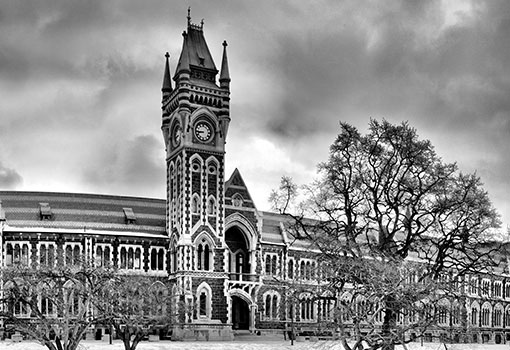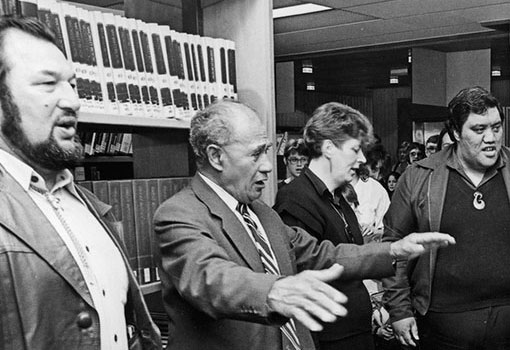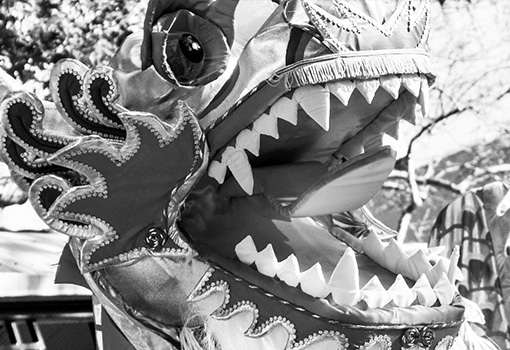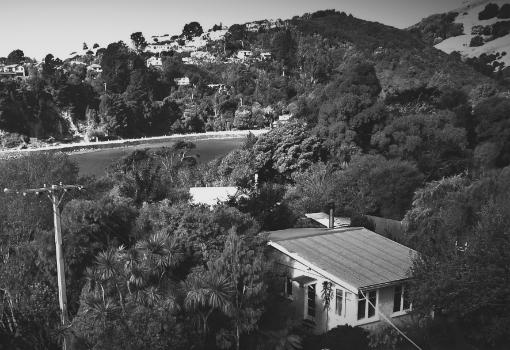
The Sunday Essay: Who shot the last huia?
By The Spinoff - Kathryn van Beek | Posted: Thursday Jun 22, 2023
It might have been my uncle.
Read Original Article HERE
Awhile back, Mum came to visit and brought the family tree she’d been working on. She mentioned something about an uncle William who’d shot a huia, an uncle William who’d brought a box of tuatara to crawl around her childhood home. I glanced at a yellowed newspaper clipping of the dapper William holding a tuatara, the ancient reptile’s hands curled around his fingers, and shrugged.
Huia didn’t mean much to me. After all, they’re extinct – I’ve never seen one, or heard its call. But the knowledge that I had an uncle who’d shot an endangered bird lodged like a bullet in my brain.
By the time I wanted to learn more about William and the huia, Mum was on holiday in Austria, and the different time zones hampered my quest for information. I didn’t think it would be too hard to track down the huia-shooting uncle without her – all I needed to get started was the maiden name of my Nana, Myrle Elizabeth Boon Chappell. But the single google result was an image of Nana’s headstone, which only recorded her married name. Nana died before the internet became ubiquitous, but I still wondered how someone with such a distinctive name could be so difficult to find.
Then I remembered the family tree. I excavated a copy from my emails and found Nana’s branch – the Dawbins. The last confirmed sighting of a huia was in 1907, meaning my suspects were William Joseph Dawbin, born in 1859, or his son – also named William Joseph – who went by Willie.
But neither of these Williams could have been the protagonists of Mum’s stories about the tuatara in the lounge. The older Dawbin died in Feilding in 1951, the younger in an English hospital in 1915. Neither of them lived long enough for Mum to have memories of them.
I found a branch of the family tree where a sister accidentally shot herself while climbing through a fence, and a brother died after riding his motorbike into a cow. Neither of them were likely huia killers. But below them I found Nana – and her brother, William (Bill) Henry Ivo Dawbin. Bill was born near Feilding, and died in Sydney in 1998. Occupation – zoologist. And unlike Nana, he’d left a paper trail.
Described in academic literature as an “important cetologist” and “not always easy to get on with”, Bill Dawbin began his career as a research assistant to future Nobel Prize winner Sir John Eccles at the University of Otago. He spent his WWII service on the Auckland Islands as a member of secret coast watching programme The Cape Expedition, conducted research on humpback whales that still informs their conservation management today, and was one of the first scientists to study tuatara.
I wondered if I’d reached back through my family tree to find a kindred spirit, but I soon learnt that Dawbin had a different relationship with animals than I do. His contemporaries describe him butchering whale carcasses and endearing himself to whalers by sharing both their brutal conditions and their diet of whale meat and beer.
Dawbin’s research contributed to international controls on whale catches – but not everyone stuck to the rules, and soon humpback whales were on the brink of extinction. When New Zealand’s last whaling station closed in 1964, Dawbin called it “a sad end to such a fine industry”. It was also a sad end to his fine career. Just as Dawbin was rising to prominence, his subject-matter vanished – and along with it, his industry and academic influence.
Dawbin seems to have been a brilliant but polarising character. Reports of his extensive networks and close industry ties hint at conflicts of interest, and a colourful obituary in Marine Mammal Science reads, “Fisheries officials sometimes complained that Dawbin seemed to think of the frequent airplane tickets they purchased for him to fly around the Pacific as an excuse for some very prolonged and expensive family vacations.”
At one point he contracted malaria, which can cause cognitive and behavioural changes, and the obituary noted his unhappy family life. I remembered the tone in which Mum had spoken of him – a blend of grudging admiration and annoyance.
Dawbin had witnessed, and at times participated in, the near-extinction of the humpback whale. But had he also contributed to the extinction of the huia? He was born in 1921, well after the last official sighting of the bird. But credible huia sightings were recorded right up until 1963. With his charm and connections, could my great uncle have shot a huia and got away with it? Could my great uncle have shot the last huia?
‘We want to cover Election 2023 with rigour, range and humour. To do that, we need your help.’Editor-at-largeDonate today
I’d unwittingly followed in Dawbin’s footsteps to the University of Otago. But where Dawbin assisted with important research on synaptic transmission, I – an arts fellow – spent my time scrawling sentence fragments on coloured post-it notes and staring out my office window at a tree.
Past the tree, past the university library, is Tūhura Otago Museum. I went over to ask if they had a huia exhibit, and was directed to the third floor. In the lift on the way up, another staff member asked what I was there to see.
“The huia,” I confessed, hoping he couldn’t sense I was related to a bird murderer.
His eyes twinkled. “You should read The Book of the Huia,” he said.
Out of the lift, past a taxidermy leopard seal with shining teeth, was a display of extinct birds. A South Island kōkako, a New Zealand Little Bittern and a Laughing Owl sat like Snow Whites in their glass coffins. “Many New Zealand birds failed to adapt to human-induced change”, a victim-blaming sign above them read.
The pair of huia were bigger than I’d imagined, and beautiful, with glossy green-black feathers, orange wattles, and white-tipped tailfeathers. The male had a straight, stout beak, whereas the bill of the female was long and curved. Huia were described as curious, trusting and loving. An 1889 article from Lyttelton Times reads:
“The birds enjoy posing in all sorts of attitudes, spreading out their tails like fans, billing, cooing, and flirting in the most old-fashioned and pretty manner. At night the pair nestle close together, slumbering peacefully till another day dawns . . . They are easily snared by hand, seeming to have no sense of fear.”
The huia was named after the sound of its song: “uia, uia, uia”. To the ears of English speakers, the call is said to have sounded like “Where are you? Where are you? Where are you?” In a 1949 recording, elder Hēnare Hāmana (Ngāti Awa) whistles the bird’s haunting song.
Huia tailfeathers were considered tapu by Māori, and were worn to denote rank or mark significant occasions. Huia feather and beak adornments later became a fashion craze among Pākehā in Aotearoa and London, and hunters were handsomely rewarded.
More than a century after its last confirmed sighting, the lure of the huia hasn’t gone away. Those gripped by extinct bird fever can still get huia beak earrings ($225, Nick von K, “carved from ethical moose antler”) and huia feather jewellery ($419, Boh Runga, sterling silver).
But the huia wasn’t only a victim of fashion. With the logic of the old woman who swallowed a fly, Europeans bred and released ferrets in the hope of conquering the rabbits they’d also released. Between the introduction of predators and the logging and burning of habitat to create farmland, the inquisitive, sedentary huia didn’t stand a chance.
As numbers declined, people rushed to secure the last prized specimens for themselves. These vandals were not only hunters and poachers, but also noted ornithologists such as Sir Walter Buller. Buller’s belief that huia were doomed to become extinct was a convenient rationalisation for his own dealings in their cadavers. His quotes from this period make him sound like the villain from a farce:
“A huia came bounding along, almost tumbling, through the close foliage . . . This gave me an opportunity of watching this beautiful bird and marking his noble bearing, if I may so express it, before I shot him.”
“To show how much scarcer this bird is than it was formerly, I may mention that in 1892 I made an expedition into the wooded ranges at the back of the Waikanae . . . During the whole expedition we only saw a single huia—which I shot.’
“A pair of huias, without uttering a sound, appeared in a tree overhead, and as they were caressing each other with their beautiful bills, a charge of No.6 brought both to the ground together. The incident was rather touching, and I felt almost glad that the shot was not mine, although by no means loth to appropriate the two fine specimens.”
With his lust for adventure and glory threatening to undermine his contribution to knowledge, the whale-butchering Bill Dawbin struck me as a bit of a Buller character. He was surely the killer I was looking for. But then Mum sent me a Whatsapp message: “My great uncle Willie shot the huia.”
Born in 1888, William Joseph Dawbin became a trooper in the Wellington Mounted Rifles and was shot in the spine on the Gallipoli Peninsula during WWI. He was 27 when he died. The uncle William who’d shot the huia and the uncle William who’d had tuatara crawling around the living room were two different men.
Mum sent me a photo of Willie’s ornate marble headstone. I searched his name in the Alexander Turnbull Library collections, found a record called “Dawbin family papers” and asked how to access it. A few days later, I had a reply. Along with the instructions for requesting a microfiche inter-loan was this note:
“Incidentally I used to work at the Manawatū Museum in Palmerston North. We borrowed a diary written by William Dawbin for an exhibition I developed at the museum on huia. A young William had shot a huia in the Ruahine Ranges and took it to a taxidermist to get it stuffed, all of which he recorded in his diary – it made a great addition to the display.”
The next day I got hold of Mum on the phone.
“I grew up with the stuffed huia in my grandmother’s lounge, but I don’t know anything about Uncle Willie – nothing at all,” she said. “He was dead before my mother was born. All I know is that he was kind of a hero in the family. His family must have thought he was a hero to have built such a gravestone.”
Nana had been in possession of Uncle Willie’s diaries for a time, and Mum remembered reading them. “One entry said ‘I shot a huia today’. That’s all it said – like ‘I shot a sparrow’. They would have had no concept that they were basically exterminating them.”
Mum might not have not known much about war hero Willie, but she never forgot her uncle Bill. His successes and adventures must have been salt in the wound for Nana.
“He was given every opportunity, whereas my poor mother had to leave school to look after her baby sister when she was about 15,” Mum said. “Bill was a boy, he was highly intelligent, he was going to go on to do great things. He was put on a pedestal by the family. But Nana topped the country in biology. She felt very miffed that she didn’t have opportunities.”
Later, when the conversation circled back to Bill, Mum’s tone of exasperation returned.
“What was he doing running around the country with a box of tuatara?”
The microfiche inter-loan arrived, and I spent an afternoon scrolling through the Dawbin family papers. They included an account of the last three months of Willie’s life, written by his English cousin Polly. A regular visitor to the hospital, Polly would arrive bearing eggs, apples, roses and good cheer. Though the bullet in his spine was slowly killing him, in her records Willie came across as stoic and gracious – the epitome of the gallant soldier.
There was a write-up about Willie’s headstone in the local newspaper. Engraved with laurels, a crown, and a riderless horse, it was considered a fine addition to the local cemetery. “The whole is certainly a great work of art,” the article concluded.
There was also a photo of Willie looking handsome in his military uniform. It was taken before the boy who carelessly destroyed a huia was carelessly destroyed by war.
But perhaps Willie the hero shared some traits with Bill the gung-ho cetologist. Because it’s not true that people of Willie’s era didn’t realise the huia was in peril. In a 1902 letter to the editor of the New Zealand Herald, a correspondent wrote:
“The way this beautiful and harmless bird is being ruthlessly shot down for the sake of its few tail feathers is scandalous. I know myself that there are scores of men who make a living by huia shooting. The Duke of Cornwall and York settled the doom of the poor huia by wearing a feather in his chapeau.”
The final confirmed sighting of a huia was made when Willie was about 19. Willie may well have shot the last huia.
Heeding the museum worker’s advice, I sought a copy of W. J. Phillipps’ rare 1963 volume, The Book of the Huia. It’s hardback, sky blue, with an attractive painting on the cover. One copy was available on TradeMe for $225. I wanted it. I wanted to be able to finger through its thick, hand-cut pages, its glossy photographic plates. I wanted to display it on my bookshelf as a marker of my taste. I added it to my TradeMe wish list.
What is it about beauty that makes us want to possess it, hoard it, even if we destroy it? The Book of the Huia is filled with accounts of humans keeping huia as pets and accidentally killing them. We pick beautiful flowers and put them inside to wither. We breed dogs to our aesthetic specifications – even if it means they can’t breathe. A woman’s lover or ex-lover is her most likely killer. The threat of losing something just makes us want it more.
When we hear about glaciers disappearing, is our first thought “I must reduce my carbon emissions” or “I must go and see them before it’s too late”? After the Australian bushfires, the melting of our glaciers was hastened by koala cremains blowing across the Tasman Sea and scattering over the ice. Elsewhere, glaciers have been found to contain microplastics from fashion. These harmful particles are flushed into the environment by our washing machines and end up in krill, in the fish we eat, and in humpback whales.
Though published in 1963, The Book of the Huia is optimistic about the bird’s fate. It lays a trail of breadcrumbs for would-be huia sighters, recommending times of year and types of habitat for searching.
“If the huia is indeed extinct, this book will be something of a memorial tribute,” the foreword reads, somewhat bullishly. But on the facing page, a poem by Eileen Duggan tells a different story. “Where is the Princess of tree and hill? Where is the Queen?” it asks. “Under what sky is it dreaming now? Under what star?”
The poet already knew what the experts couldn’t bring themselves to believe.
A similar lament might have been written about humpback whales had whaling not come to an abrupt end. But why had we hunted whales in the first place? I turned to yet another William – the University of Otago’s Associate Professor of Marine Science, Will Rayment – to find out.
From the moment Will blew into the university’s staff club – all muscles, ear-to-ear grin, and water-resistant clothing – it was obvious that not everyone spends their university workdays gazing out at autumn leaves and shuffling post-it notes with phrases like “all is lost” scribbled on them.
Will said that like huia, whales were subject to the whims of fashion. “Baleen whales, like humpbacks, have these big, sieve-like structures in their mouths made of keratin. It was the pre-industrial revolution plastic, used in corsets and parasols. And whale oil was literally used to grease the gears of the industrial revolution.’
We lost interest in burning whale fat when we started burning fossil fuels, and the economic value of whales now lies in ecotourism. Humpback whales have a charisma that captures people’s imaginations.
“They’re really acrobatic, they have a complex song, and they make these migrations from the tropics where they breed. That’s what Bill Dawbin studied. He was responsible for revealing their path of migration.”
“Had you heard the name Bill Dawbin before I emailed you?” I asked.
“He’s a famous name in cetology,’ Will said. ‘I’ve seen a picture of him holding a tuatara – he sounds like a classic old biologist.”
There must have been times during Bill Dawbin’s career when he thought that, like Sir John Eccles, he might win a Nobel Prize – but once the humpback whales disappeared, so did his chances.
Dawbin may not have realised all his dreams, but he left a lasting impression. But what about his sister, my Nana, Myrle Elizabeth Boon? The girl who topped the country in biology? In the shadow of her brother, she’s as cryptic as a skink.
By examining drawings of huia, viewing their bodies in museums, and hearing Hēnare Hāmana imitating their song, we can put together an impression of what a huia might be. Through written records I can also put together an impression of Bill Dawbin, and even of Willie. But when it comes to my Nana, I’m left thinking of the huia’s call: “Where are you? Where are you? Where are you?”



